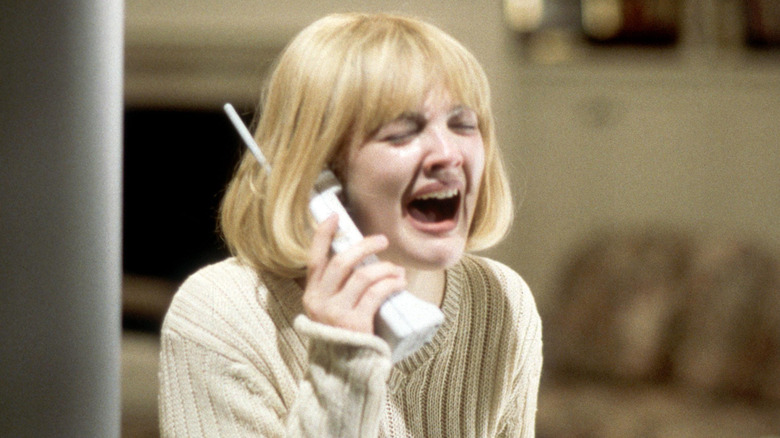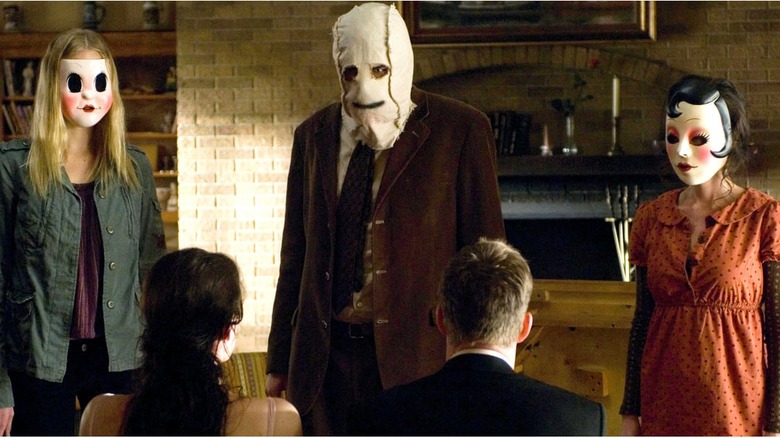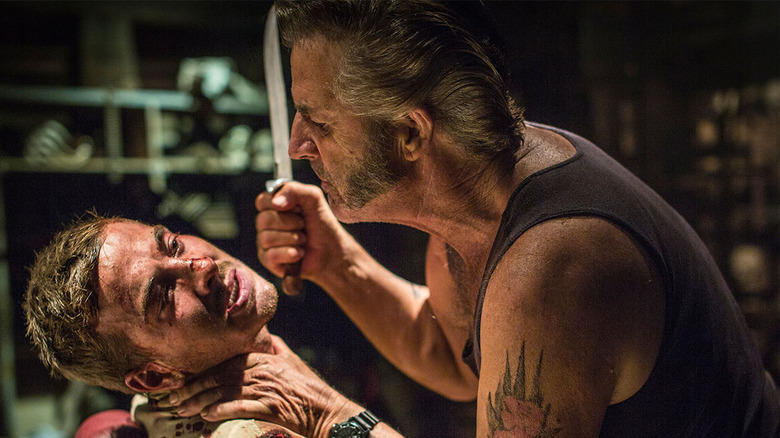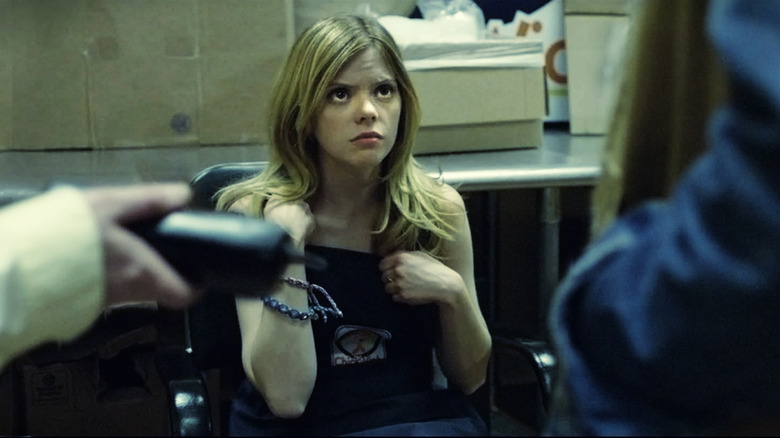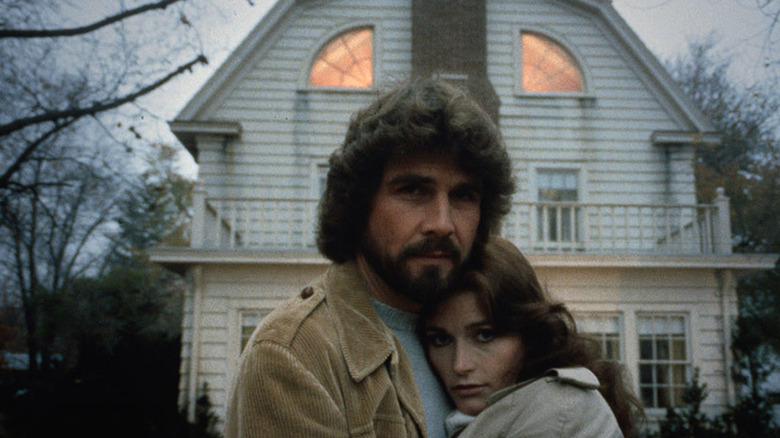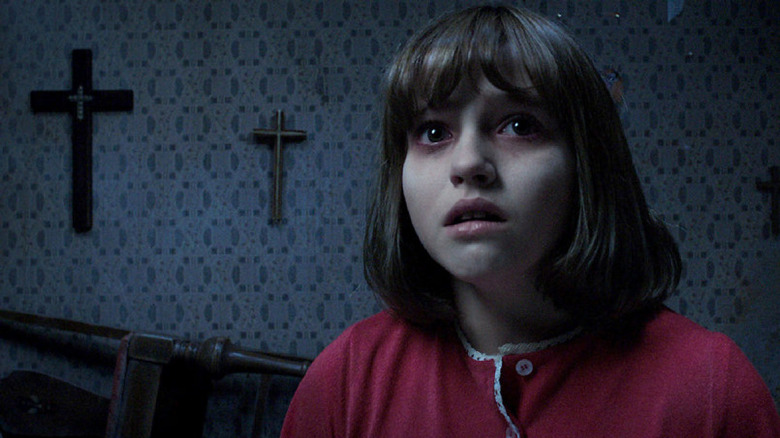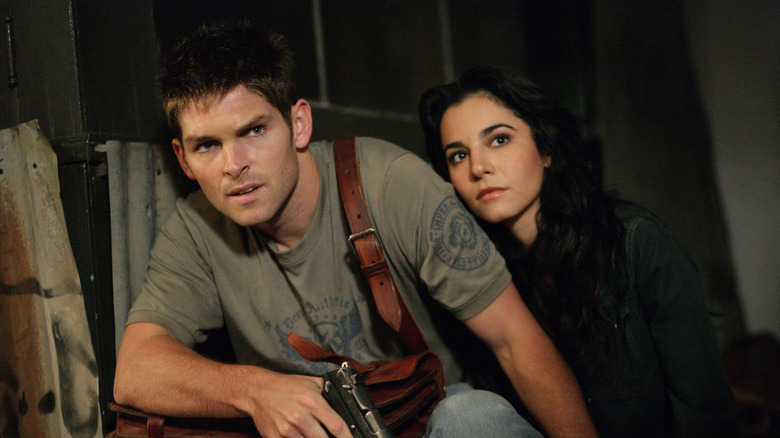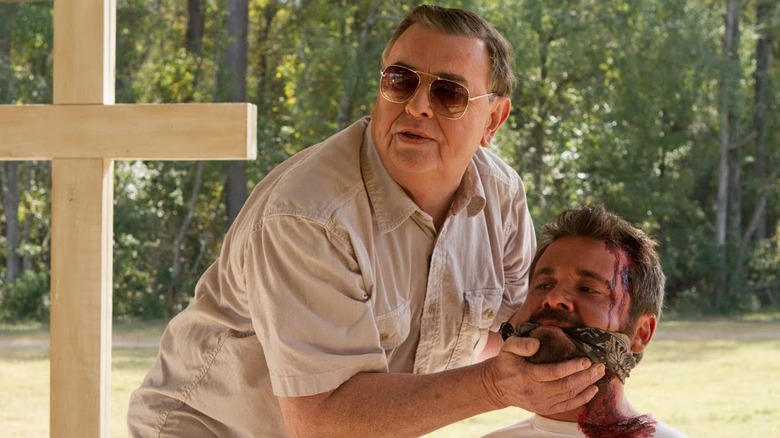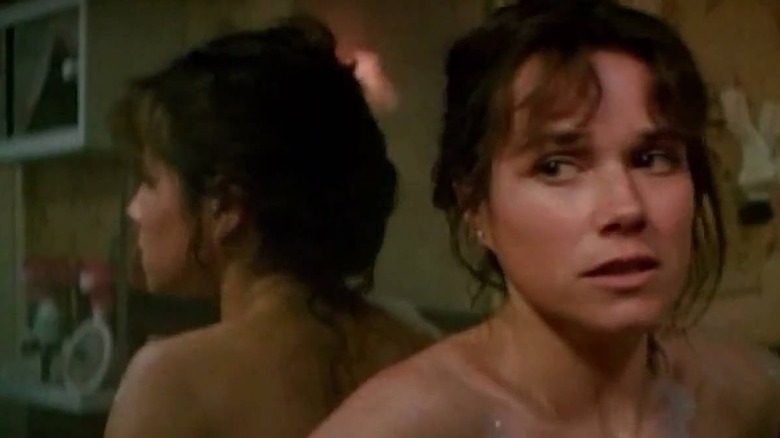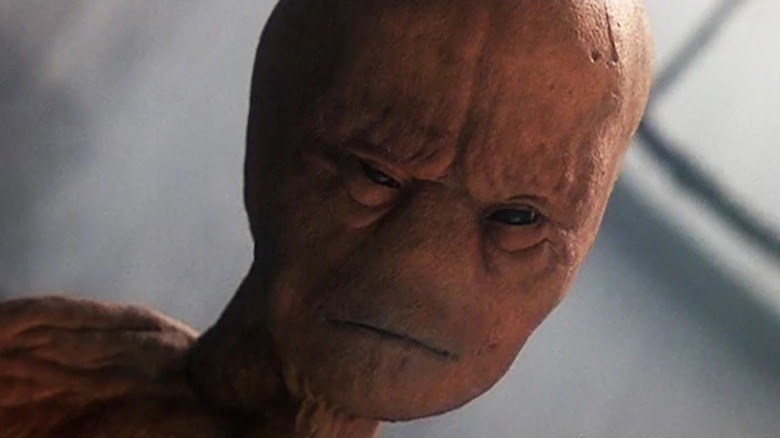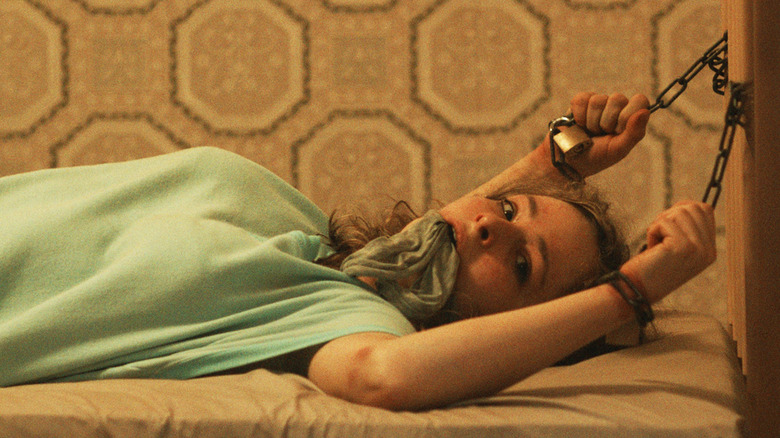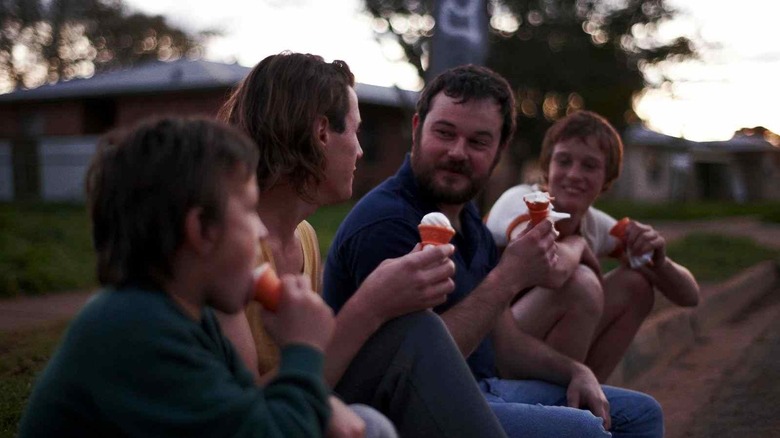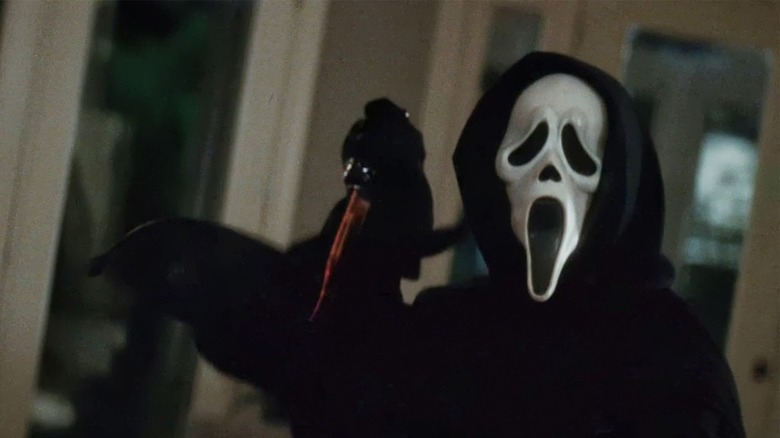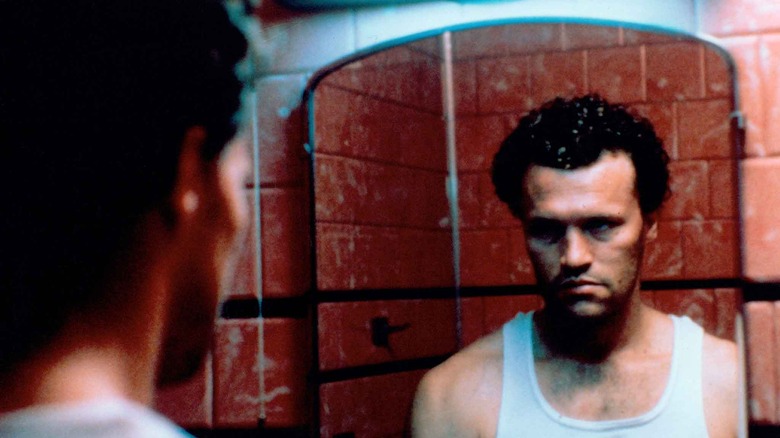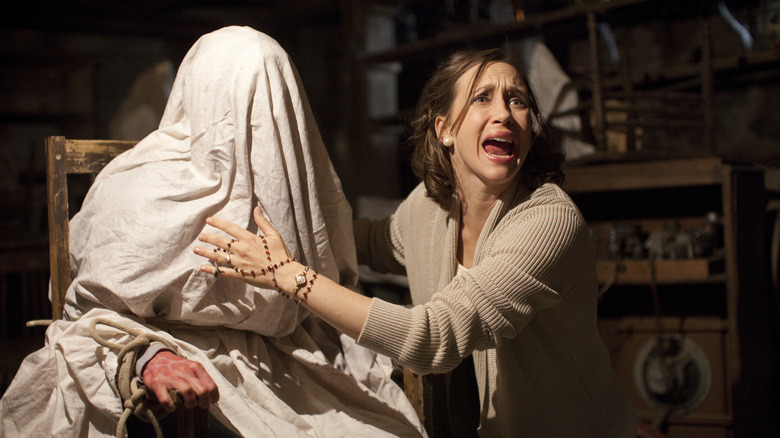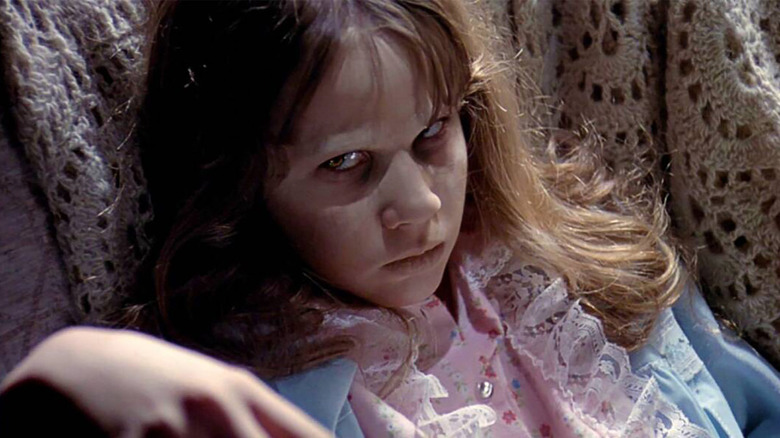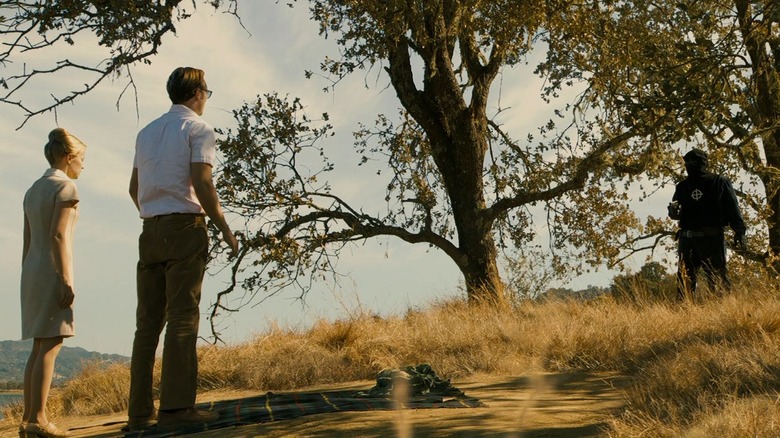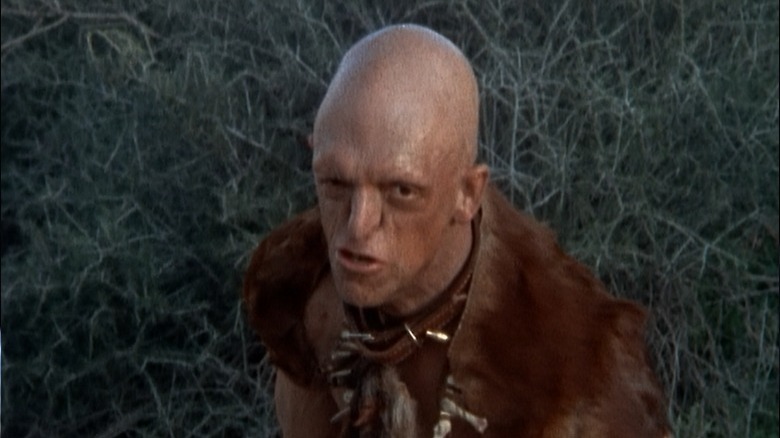18 Horror Movies Based On True Stories That Will Creep You Out
The phrase "based on true events," is guaranteed to generate hype for any horror movie. Horror is already meant to be terrifying, so declaring that it actually happened only ups a film's fear factor. It also generates a ton of buzz, as curious viewers want to know the story behind a film, as well as how true it actually is.
After all, the world is a terrifying place. Serial killers like Ted Bundy and Jeffrey Dahmer targeted and killed young people to satiate their violent impulses. Claims regarding demons, ghosts, and other paranormal creatures are harder to validate, but in this uncertainty lies ample opportunity for writers and directors to try to make even the staunchest skeptic question reality.
These 17 horror movies are based on actual events involving serial killers, supernatural entities, and even aliens. Lock your windows, grab your Bible, and get ready to dive into a world of real-life horror.
The Strangers
Directed by Bryan Bertino, "The Strangers" is a lean and mean piece of horror about three masked strangers who terrorize an estranged couple (played by Liv Tyler and Scott Speedman) simply because they happen to be at home. The group determines that the couple is around when one of the members knocks on their door and asks, "Is Tamara home?" That's all the invitation these invaders need to begin their horrific game of cat and mouse.
Chillingly, this actually happened to Bertino when he was a child — someone knocked on his front door, asking for someone who didn't live there. Bertino later learned there was a series of break-ins in his neighborhood around the same time; the robbers would target houses where no one answered the door. He also said that the film was inspired by the Manson family murders. While Bertino has never corroborated this theory, many viewers also speculate that the film is based on the Keddie murders, an unsolved homicide in which a family of three and a friend were brutally stabbed and beaten to death in their cabin in Keddie, California.
Wolf Creek
In the 2005 torture film "Wolf Creek," killer Mick Taylor is an amalgamation of two serial killers who murdered backpackers in the Australian outback. Active from 1989 to 1993, Ivan Milat killed seven victims – five foreign tourists and two Australians — and became known as the Backpack Killer. He would pick up unsuspecting campers who were hitchhiking to parts of New South Wales, but instead of taking them to their destination, he brought them to Belanglo State Forest, where he murdered them with various weapons.
In 2005, Bradley Johnson Murdoch was convicted for the murder of British tourist Peter Falconio and the attempted abduction of Falconio's girlfriend Joanne Lees, who survived the ordeal. Falconio's body was never found and he is presumed dead. Lees was able to escape capture by hiding in the bush and eventually finding her way to a roadway to get help.
In discussing his inspiration for "Wolf Creek," McClean says that he wanted his villain to encapsulate the "xenophobia, homophobia, sexism, racism, all that kind of stuff that we [Australians] squash down but is alive and well."
Compliance
A series of crimes dubbed the Strip Search Phone Scams, which ran from 1992 to 2004, inspired Craig Zobel's 2012 film "Compliance," in which fast food employees are forced to violate each other by a man on the phone who claims to be a police officer. As in the movie, the actual crimes targeted fast food restaurants across the country. A man would call the restaurant, ask for a manager, and say he was a cop or another authority figure. He would explain that he was investigating a female employee, and that the manager needed to interrogate her to get a confession. Incidents included strip searches of several employees, and even a cavity search for drugs.
Following a call gone wrong in 2004, David R. Stewart was arrested for his 12-year-old scam, impersonating a police officer, and the gross manipulation of so many people. He wasn't an officer, of course, but just a regular guy who was married with five children and was obsessed with joining the police. Stewart was only convicted for that final call, but he's suspected to be responsible for all of them.
"Compliance" follows the final scam rather closely, though it adds more sexually explicit details to up the shock factor. It even includes the use of security footage to catch the creep, which is how police were able to capture Stewart.
The Amityville Horror
Stuart Rosenberg's 1979 film "The Amityville Horror" is based on the 28-day haunting of the Lutz family. In both real life and the film, the previous owners of the Lutzs' new home were murdered in their beds by their son, Ronald DeFeo, two years before the Lutz clan moved in. When Kathy Lutz brought in a priest to bless the home, he heard a voice loudly declare, "Get out." Get out he did.
The events became progressively worse — the family smelled foul odors and observed other bizarre activity (the Lutz family claims the actual events were too horrifying to discuss). The infamous Ed and Lorraine Warren (who make a few appearances later on this list) were even involved in the investigation, refuting claims that the whole thing was fake.
"The Amityville Horror" is still thought to be a hoax due to a lack of evidence, as well as George Lutz's supposed involvement with the occult. But Rosenberg didn't care about that. Regardless of what is true, it's one scary concept. The film did take some liberties, however, having George become completely possessed and pushing him to the brink of committing murders similar to DeFeo's.
The Conjuring 2
Ed and Lorraine Warren are known as the con men of the paranormal world, exploiting the desperate for fame and recognition. But in James Wan's "The Conjuring" franchise, the Warrens (Vera Farmiga plays Lorraine, and Patrick Wilson plays her husband, Ed) became ghost-hunting Catholic superheroes.
The second film about the Warrens, "The Conjuring 2," is based on the case of the Enfield Poltergeist, which tormented a single mother named Peggy Hodgson and her four children in their north London home. For 18 months, Hodgson and her family claimed that they saw furniture moving by itself, heard knocks and disembodied voices, and actually levitated. The youngest daughter, Janet, played in the film by Madison Wolfe, allegedly became possessed by the poltergeist, who spoke through her and told investigators he was the ghost of Bill Wilkens, who died in the house (this was corroborated by public records).
It wasn't just the Hodgsons who had a brush with the paranormal, either. Over 30 people, including journalists, neighbors, and other investigators, witnessed some sort of activity. However, the Warrens were not as involved in the case as "The Conjuring 2" would lead you to believe. In fact, the Warrens showed up to the house unannounced and were initially not allowed inside. Regardless, regarding the case, the real-life Ed Warren said, "Those who deal with the supernatural day in and day out know the phenomena are there — there's no doubt about it."
Borderland
"Borderland" is based on the horrific murders committed and overseen by Adolfo Constanzo, a practitioner of Palo Mayombe who led a cult he called the Narcosatanists. In his own practice of Palo Mayombe (an established African religion), Constanzo committed human sacrifice to feed his nganga, a special cauldron that he believed protected his group from harm — see, in addition to cultists, they were also prolific drug traffickers (and no, human sacrifice is not typical of the religion). In total, Constanzo was responsible for 15 confirmed deaths, although it is thought that the number could be much higher.
"Borderland" tells a fictionalized story about actual victim Mark Kilroy, an American student who was kidnapped, tortured, and ritualistically killed to protect the Narcosatanists from being apprehended by the police. It also closely follows the rituals and practices of Palo Mayombe, choosing to explain the religion rather than simplifying it or removing it to make the film more palatable for a wider audience. In fact, the inclusion of Palo Mayombe in "Borderland" makes the film all the more terrifying, as the viewers realize that these are actual traditions that have been practiced in the real world.
The Sacrament
Ti West's 2013 found-footage film "The Sacrament" is based on the Jonestown Massacre of 1978, committed by the Peoples Temple's cult leader Jim Jones at the religion's compound in Guyana. The compound was where Jones fled from the police investigation into his cult, which was being exposed for questionable practices from ex-members. Jonestown, the inspiration for Eden Parish in "The Sacrament," was supposed to be a socialist utopia, but was actually front for Jones' mistreatment of his followers. After being investigated by US representative Leo Ryan, a group of defectors asked for help leaving Jonestown. Chaos broke out, and acolytes shot at Ryan's plane to prevent the ex-cultists from returning to the United States.
There are no politicians in "The Sacrament," but a camera crew does help defectors with their helicopter, which also leads to a shootout. Amidst the shooting, Jones forced his parishioners to drink cyanide-laced Kool Aid. In total, 918 people died in Jonestown. Through the found footage format, "The Sacrament" adds a new perspective to the well-known story; this isn't a biopic, but a harrowing recreation of what it would be like to live through such an experience.
The Entity
"The Entity" is based on a particularly upsetting true story in which a woman was repeatedly raped by an unseen force. The film, starring Barbara Hershey, is inspired by the case of Doris Bither, a mother of four who told parapsychologists that she was being raped by an invisible person on a regular basis. When she turned to scientists to help figure out what was happening to her, they began observing her to determine the validity of her claims. During this process, scientist Barry Taff captured photos of the supposed phenomenon. He claims on his website that Bither wasn't experiencing ghostly sexual assault, but "a rather disturbingly real poltergeist outbreak."
"The Entity" makes Hershey a sympathetic character who is doing her best as a single mother. Not much is known about the actual Bither, except that her relationship with her children wasn't great and that she experienced a great deal of childhood trauma.
Fire in the Sky
"Fire in the Sky" is an alien abduction film based on the book "The Walton Experience," which was written by Travis Walton, an actual alien abductee. Walton was a logger who, along with his coworkers, discovered a saucer-shaped flying object floating in the woods. He made the questionable decision to approach it and was subsequently brought inside the vessel via a bright beam of light. This was witnessed by his co-workers, who drove away in fear. While in the ship, Walton says he fought small, bald creatures until a human being calmed him down and placed a mask over his face, knocking him out. Walton woke up five days later on the side of a highway.
Since Walton's memory of the abduction was very hazy, "Fire in the Sky" screenwriter Tracy Tormé took quite a few artistic liberties to create an effective horror movie. The prime example is the graphic depiction of Walton's time with the aliens, which includes being trapped on a table by a strange suffocating membrane and a probe that goes through his eye.
Hounds of Love
"Hounds of Love," directed by Ben Young, is loosely based on the crimes of David and Catherine Birnie, who kidnapped and murdered four women — a fifth victim actually escaped their grasp. "Hounds of Love" is about that final victim, her experience with her abductors — in "Hounds of Love," named John and Evelyn White — and her subsequent escape.
David and Catherine Birnie committed their crimes over a period of five weeks, kidnapping young female hitchhikers and bringing them to their home. David raped the girls while Catherine watched. Then, they murdered the victims and buried them in shallow graves. Kate Moir, the basis for the character Vicki Maloney, escaped when Catherine forgot to chain Moir to the bed before she left the house. Moir then slipped through a window and ran to find help. She led the police to the Birnies' house, where they were arrested for their crimes.
"Hounds of Love" is only loosely based on the Birnies, but Young closely follows Moir's story while also adding disturbing depth to the fictional killers' dysfunctional romantic dynamic.
The Snowtown Murders
"The Snowtown Murders" is a grisly biopic about the actual Snowtown killings, which were also known as the "Bodies in Barrels" murders. These crimes were not the work of just one person, but rather a group of four who became some of Australia's most infamous serial killers: John Bunting, Robert Wagner, James Vlassakis, and Mark Haydon, who helped dispose of the bodies.
Between 1992 and 1999, Bunting, Wagner, and Vlassakis tortured and killed 12 people, then disposed of their dismembered remains in barrels. Unlike most serial killers, the trio killed people they knew. Specifically, they targeted friends and family members who Bunting declared weak, particularly pedophiles and those who identified as gay. Before killing them, however, the men tortured their victims, crushing their private parts and breaking toes with pliers. Their final victim was Haydon's wife, who Bunting thought was too promiscuous; Haydon didn't express any remorse or grief over her death.
"The Snowtown Murders" director Justin Kurzel captures the increasingly horrific specifics of the case in intimate detail, never sugarcoating or trying to soften the horrendous story.
Scream
Why, yes, Wes Craven's meta-horror masterpiece "Scream" is in fact based on a true story. Specifically, "Scream" writer Kevin Williamson was inspired by the Gainesville Ripper, aka Danny Rolling, who killed a total of eight people. The Gainesville Ripper first gained notoriety in August 1990, when he broke into several apartments and stabbed five students. Rolling's killings were not only violent, but he also posed the bodies in sexually suggestive positions and carefully staged the crime scenes to create maximum repulsion. He was later charged with a further three homicides.
One of Rolling's most shocking actions occurred when he realized that he left his wallet at a crime scene. He went back to retrieve it, and decided while he was there to decapitate one of his victims and place her head on a shelf. While Rolling's specific crimes don't occur in "Scream," Williamson was inspired by the student-focused killing spree to write a story about a killer who taunts young women over the phone.
Henry: Portrait of a Serial Killer
If you're looking for the most disturbing film on this list, "Henry: Portrait of a Serial Killer" is it. It features a fictionalized version of Henry Lee Lucas, a serial killer active from 1960 to 1963 who was also known as the One-Eyed Drifter Killer and the Confession Killer.
In total, Lucas was convicted for three murders and was assumed to have committed eight others; he claimed that he'd killed hundreds. Lucas is the epitome of a drifter killer, meaning that he moved from place to place, killing at random, which made it more difficult to apprehend him. But Lucas didn't just murder; he raped, robbed, attempted to kidnap children, and committed many other horrific crimes. He kept company with people like Ottis Toole (played Tom Towles), a large and intimidating drug dealer who became his accomplice.
"Henry: Portrait of a Serial Killer" is so frightening because it is filmed like a home movie, complete with a shaky camera and grainy footage that makes it feel like a video tape you'd find buried in a closet. Michael Rooker plays Lucas, and his actions feel quite real, making the experience akin to watching a snuff film.
The Conjuring
The Warrens make another appearance on this list, this time with the first film in the franchise that depicts the real-life charlatans as good and virtuous people. The first "Conjuring" film centers on a family of seven — a mother, a father, and their five daughters — who move to a farmhouse full of demons and spirits who torment the family. The story is based on the Perron haunting, which was one of the Warrens' most prominent cases.
The Perrons moved into a 14-room farmhouse in 1971 and immediately began experiencing strange phenomena, which started with missing items and escalated to full-on possession. The film is rather true to the real-life events, including the name of the spirit, Bathsheba, who was an actual person who supposedly lived on the property in the mid-1800s. However, Ed Warren did not perform the climactic exorcism in the film; instead he conducted a séance, as he did not have permission to perform the sacred rite.
The Exorcist
William Friedkin's 1973 horror classic "The Exorcist" is often cited as one of the scariest movies of all time. What makes it even scarier is that it is based on the actual exorcism of Roland Doe in 1949 (Roland Doe is not the boy's real name, but the one used to protect his family's privacy).
While Roland becomes Regan in the film, Friedkin said that most of the film's events were actually observed by Doe's family during the possession, as verified by those involved. He also consulted the journals of the priests who performed Doe's exorcism to ensure that he got the details right. Strange things started happening to Doe's family after the death of his aunt Harriet, with whom Doe was very close. As an only child, Doe clung to Harriet, who introduced him to Ouija boards and spiritualism. After her passing, objects would levitate and fly across the room when Doe was nearby.
As the possession got worse, a number of exorcisms were performed on Doe. One was halted after Doe ripped a box spring out of a mattress and sliced a priest's arm open. During the final, and successful, exorcism, strange marks appeared on Doe's body, he broke a priest's nose, and his head reportedly spun around (although that was never corroborated). These days, however, Doe's case is thought to be a fake, merely a case of a mentally ill teenager.
The Texas Chain Saw Massacre
Tobe Hooper's debut film, "The Texas Chain Saw Massacre," is a classic horror film about a family of cannibals who prey on young tourists, with the infamous Leatherface wearing their skin. This horrifying premise is, unfortunately, based on the story of Ed Gein, a murderer and grave robber who exhumed the dead bodies of local women, cut off their skin, and wore it. Gein always stole bodies that resembled his mother, with whom he had a very fraught relationship. Among the paraphernalia and the clothes he created was a skull he used as a bowl, leggings made of human skin, and a collection of vulvas.
Hooper took Gein's disturbing actions and turned them into something even more upsetting, adding cannibalism and a lot of very graphic murder involving meat hooks and chainsaws to the mix. Gein was only convicted of two murders, so he wasn't a serial killer; he was just deeply disturbed. His crimes didn't just inspire Hooper, either. His story was also the basis for Alfred Hitchcock's "Psycho" and Jonathan Demme's "The Silence of the Lambs."
Zodiac
The Zodiac Killer terrorized the San Francisco Bay area in the late '60s, killing a confirmed five people, though he claimed in cryptic notes to have killed 37. Even more terrifying, the Zodiac Killer was never caught. David Fincher took that bone-chilling story and adapted it into the 2007 film "Zodiac," which documents the lives of the men who became obsessed with trying to solve the case. Political cartoonist Robert Graysmith (played by Jake Gyllenhaal), journalist Paul Avery (Robert Downey Jr.), and Detective David Toschi (Mark Ruffalo) were all real people who were deeply involved in the hunt for the Zodiac Killer, and became fixated on catching the perpetrator.
All of the murders and attempted murders from the film, including the double-shooting of teenagers David Arthur Faraday and Betty Lou Jensen and the escape of pregnant Kathleen Johns and her baby daughter, are based on actual events. Fincher also perfectly captures the obsession that plagued the three men involved, as well as the fear that the Zodiac Killer spread across the region. While many true crime fans know the ultimate outcome of the investigation, Fincher is still able to ramp up the tension — these men got so close to finding the killer, but ultimately failed due to only having circumstantial evidence.
The Hills Have Eyes
Wes Craven may be known for crafting slasher films, but he's also a pioneer in Hillbilly Horror. His 1977 film "The Hills Have Eyes" follows the Carter family on a road trip through the Nevada Desert. Stranded due to car trouble, they become prey for a family of inbred cannibals who use the remote location to trap unsuspecting travelers. The surviving Carters descend into a type of savagery to defend themselves against the bloodthirsty locals.
Craven based the film on a real family of inbred cannibals led by Sawney Bean, a tanner living in 15th-century Scotland. Failing to find legitimate work, he retreated with his wife to a nearby cave and began robbing passersby to survive. Even more disturbing, the couple would drag victims into the cave to then butcher and eat them.
Bean and his rapidly expanding family continued these crimes for roughly 25 years, creating a missing persons crisis in neighboring villages. The inbred clan killed and ate approximately 1,000 people, salting and pickling their bodies to preserve their meat. Bean, his wife, fourteen children, and thirty-two grandchildren were all eventually caught and suffered gruesome executions. Many scholars doubt the legend's veracity and view Sawney Bean as a sort of local boogeyman. However, Craven used this story to explore what humans will do to survive.
